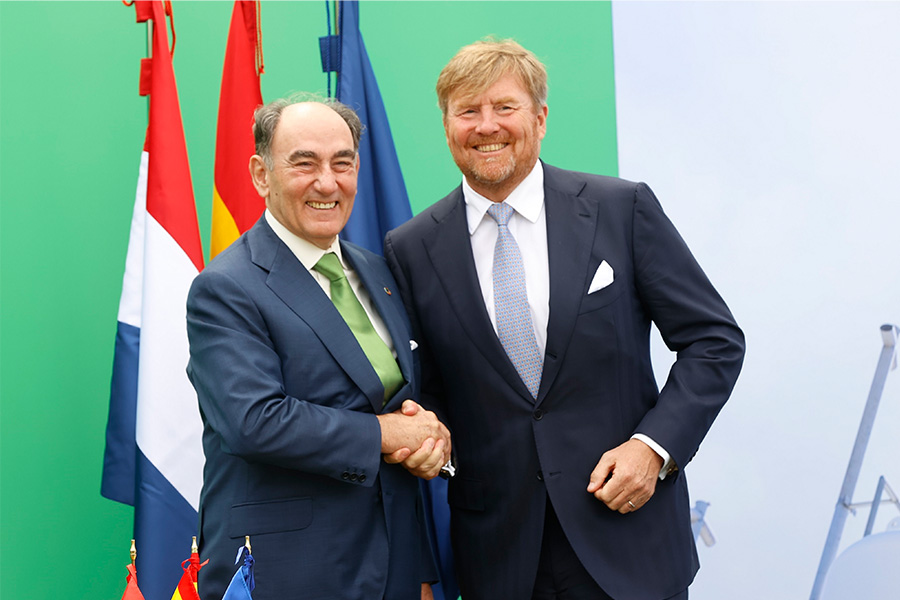The Puertollano plant, Europe's leading green hydrogen plant, welcomes the King of the Netherlands and the Executive Chairman of the Iberdrola Group to sign international agreements
- Ignacio Galán, the Executive Chairman of the Iberdrola Group, today received the King of the Netherlands at the Puertollano plant on the occasion of the signing of two international agreements to develop a maritime corridor between Spain and the Netherlands.
- The Executive Chairman of the Iberdrola Group said that the contract signed to sell ammonia includes the production of more than 100,000 tonnes per year in Huelva.
- The Puertollano plant, the main green hydrogen production plant in Europe, has received more than 180 visits from governments, businessmen and universities from all over the world.

The Executive Chairman of the Iberdrola Group, Ignacio Galán, receives His Majesty the King of the Netherlands at the Puertollano plant.
The Puertollano plant, the main green hydrogen production plant in Europe , was visited today by His Majesty the King of the Netherlands and the Executive Chairman of the Iberdrola Group, Ignacio Galán, on the occasion of the signing of international agreements to develop a maritime corridor between Spain and the Netherlands.
Thanks to the agreements signed, the Iberdrola Group, of which Iberdrola España forms part, has taken a definitive step forward in the establishment of the green hydrogen maritime corridor. The company aims to transport green ammonia to the Port of Rotterdam, to handle and store, and convert ammonia into green hydrogen, for end use in industry, or for direct use in shipping and other industries in northwestern Europe.
Ignacio Galán, Executive Chairman of Iberdrola, said that "the current facilities in Puertollano are in a first phase and in the future we aim to multiply the capacity of the plant ten times. In addition, a few days ago, we also signed a contract to sell ammonia that we will produce in Huelva, more than 100,000 tons per year. We have planned investments in this sector of more than 3 billion euros, of which more than half will come to Spain".
Mr Galán also added "when we talk about green hydrogen, we are not talking about promises, we are talking about a reality and it demonstrates Iberdrola's commitment to new technologies and to our country, as we have been doing for many years. We remain firmly committed to the Single Energy Market as the best way to promote the huge investments needed if we want a secure, clean and competitive energy industry.
The Puertollano plant has received more than 180 visits from governments, entrepreneurs and universities around the world. Among them, His Majesty the King of Spain during his inauguration, the Ministers of Energy of Australia, Chile and Slovenia, the Secretary of Environment of Brazil, the embassies of Turkey or Holland, or the Government delegations of Japan, Morocco, Colombia or Finland, as well as Chambers of Commerce from different countries.
Leader in renewable energy
Iberdrola, the group of which Iberdrola España forms part, has been investing significantly in renewable energy for more than two decades, as a core pillar to build its clean, reliable and smart business model. Thanks to this vision, the company is a world leader in renewable energy, with 40,344 MW of renewables capcity at the end of the first quarter of 2023.
Committed to the energy transition towards a low-emission economy, the company is now a leader in the green hydrogen revolution with three plants in operation by 2023. In total, there are 60 projects under development in eight countries to support decarbonisation in sectors such as heavy industry and transport.
Iberdrola España's Puertollano plant, located in Ciudad Real, consists of a 100 MW photovoltaic solar plant. It has a lithium-ion battery system with a storage capacity of 20 MWh and the largest green hydrogen production system in Europe (20 MW). With an investment of 150 million euros, it will be able to produce up to 3,000 tons of green hydrogen per year, which would avoid the emission of 48,000 tons of CO2 per year.
